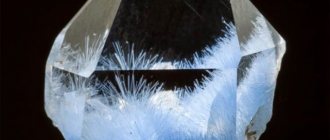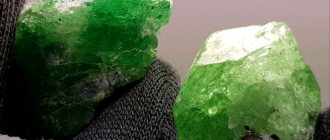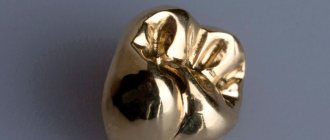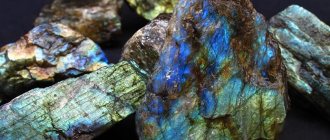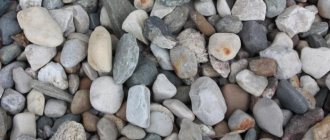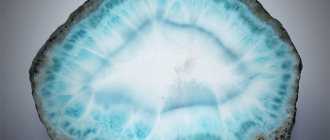| Category | Silicate minerals |
| Title in English | Grandidierite |
| Formula | MgAl3O2(BO3)(SiO4) |
| Group | Group of precious stones |
| Color | Blue; green |
| Stroke color | White |
| Shine | Glass, Mother of pearl |
| Transparency | Translucent, Transparent, Translucent |
| singonia | Rhombic |
| Hardness | 7 — 7,5 |
| Cleavage | Perfect |
| Density, g/cm³ | 3 |
| Kink | Fragile, Uneven |
| origin of name | The name of the mineral was invented by its discoverer, a professor of mineralogy from France, Alfred Francois Antoine Lacroix. At the beginning of the 20th century, a French scientist went on a mineralogical expedition to the island of Madagascar. Before Lacroix arrived, another Frenchman was doing research on the island. It was the traveler Alfred Grandidier, who studied the lifestyle of the local aborigines. The day came when the mineralogist Lacroix found a beautiful prismatic crystal on the southern part of the island. Having described the find, the professor suggested that the stone be named in honor of Alfred Grandidier - this is how the name grandidierite came about. |
| Morphology | The structure of grandidierite crystals is prismatic. A characteristic feature of this mineral is pleochroism. It is expressed in the fact that if you look at the stone from different angles, grandidierite can turn blue, light green or dark green. |
Grandidierites belong to the list of the ten rarest stones on our planet, and in fact can even be put in first place on this list, since only 8 samples have been found to date. They were discovered on the island of Madagascar, and named after A. Grandidier, who was engaged in research on the island for a long time. Grandidierite crystals are unusually beautiful; they are characterized by a pronounced white-green-blue tricolor. The first specimen of high purity grandidierite was purchased for $29,000.
Historical reference
The history of grandidierite is shrouded in mystery; this rare mineral was first discovered only at the beginning of the 20th century.
In 1902, the first crystal of grandidierite was found at Cape Andrahomana, located in the southern coastal part of Magadascar. Mineralogist from France Alfred Lacroix, who discovered the mysterious gem, proposed naming the find in honor of Alfred Grandidier, the scientist who first described the people, nature, history and traditions of the island.
It is noteworthy that 50 years later, gemologists carefully examined the location of the find, but could not even find signs of grandidierite deposits. And only in 2014, near Cape Andrahomana, not far from the place where the first grandidierite was found, a deposit of absolutely transparent crystals of the highest quality was discovered.
☘If you decide to buy a natural grandidierite stone
☘Grandidierites, their properties and characteristics. Stones that loved fame
In some works of the science fiction genre, there are often references to stone life forms that live and develop slowly; time for them does not fly, but steals. Of course, whether to believe the fiction of science fiction writers or not is everyone’s business, and we cannot know what forms of life inhabit other planets in the vast Universe. But we can easily find out about the life of the earth’s most interesting stones called grandidierites, because they develop extremely rapidly and very interestingly, like no other mineral stone , undergoing numerous changes from a simple compound to a real precious stone.
☘The beginning of mineral development
Grandidierite itself is nothing more than borosilicate in its complex manifestation. But there is nothing extraordinary about it, everything is quite simple - simple compounds of magnesium and iron with aluminum. There may be inclusions of manganese or titanium, sometimes even sodium or potassium, but not necessarily.
Boron is an abundant element in our earth's crust, so it is found quite often. This means that minerals with it often appear in its composition. If we talk about the percentage, then boron is found in nature four times more than, for example, gold. Boron deposits have also been known for a long time, and therefore grandidierites are not such a rarity in jewelry stores. But until the beginning of the 20th century, the stones led a secretive lifestyle; they were discovered only recently relative to the life of other known minerals.
☘Discovery of the mineral by galls
Grandidierite was discovered by traveling researchers from France. One of the reasons for the previous trip was to study the life of the natives of Madagascar, but a subsequent visit to the island opened up a second question of interest to the French - surveying the lands for the presence of beautiful specimens of mineral rocks, hitherto undiscovered and unstudied. That is, a question of research and profit. Both issues were eventually resolved, and each scientist received his reward. Grandidierite deposits were discovered by Professor Lacroix, but he did not name them in his honor, but gave the stone the name of his predecessor, who had once been here before him - Grandidier.
☘Search for the hidden mysterious stone
Of course, the mineral was added to the register and disclosed to the public. Its blue color with a milky tint, reminiscent of clouds, could not leave almost anyone indifferent. In addition, the stone had excellent strength characteristics, which were especially appreciated by jewelers.
The stone quickly became popular, but all the messengers sent for a new portion of the mineral returned empty-handed. The gem seemed to be hiding from the inquisitive eyes of seekers; over several decades of searching, only 20 grandidierites were found.
This contributed to an even greater increase in the popularity of the stone and, accordingly, its rise in price. All the scientists rushed to search, and only later did it become clear where to look for such an interesting stone that was hidden from human eyes. The answer was simple for people of mental work - the coast of the Indian Ocean.
☘Coming out
Only almost a hundred years later, the grandidierite stone made itself known again, and it did this while trying to pretend to be a completely different stone. Burford, a stone specialist visiting Sri Lanka at that time, bought a transparent mineral from a merchant, thinking that it was serendibite, as the seller had told him. But the secret was revealed by a meticulous scientist. The stone was sent for examination, and it turned out that it was nothing more than grandidierite in its transparent form.
☘The enormous success of the newly discovered mineral
The society exploded with news of the newly found expensive stone. New teams of searchers were urgently sent to Madagascar and Sri Lankan lands to find the mineral so desired by many. But the indigenous people themselves, having learned about the growing popularity of a stone that was simple for them, did not hide on the sidelines and moved to excavate more and more portions of gems. This entailed another wave of arriving stone hunters, who bought grandidierites from the natives for next to nothing. Sometimes, without fully understanding it, such hunters bought not grandidierites at all, but fakes, but now history is silent about this.
☘Recession of excitement. Current existence of grandidierites
Over time, the demand for grandidierites began to decline, the hype died down, and the seekers gradually left the site of their mining. Today, the demand for grandidierites is not as great as before, and people have learned to distinguish them from fakes perfectly.
Pricing policy has also become stable. The purest samples of grandidierite are, of course, expensive; in general, their cost is equal to the cost of emeralds, which is thousands of dollars. But finding a cheaper stone is just as easy. Its quality will be slightly lower, and the price will be quite high - a few dollars per carat. The range of prices when choosing this type of stone is quite wide; you can find low-quality minerals at a low price, or you can stumble upon small stones of excellent quality that cost several thousand dollars.
Of course, grandidierite cannot be called the most expensive stone on Earth. Its former glory has passed, and now its prices are no longer so high, and the demand is no longer in the form of a crazy rush. Plus, the mineral was found in other parts of the world, which made it not so rare and difficult to obtain. But even now, collectors continue to hunt for rare specimens of grandidierite, not forgetting its former glory and beauty. At the same time, the stone is still included in the group of rare stones, and therefore is of considerable value to jewelers and connoisseurs.
☘Appearance of the stone, its characteristics
As mentioned above, grandidierites are quite a tasty morsel for collectors and stone lovers. Until recently, the stone was considered almost the rarest mineral on Earth, but just some 15-20 years ago new deposits of an expensive and desirable mineral at that time were discovered. Now the value of the stone, of course, has decreased; it has been dethroned from the pedestal of the rarest mineral, becoming just one of them.
This is a silicate that has in its group not only transparent colors, but also impurities of various colors. For this reason, it is often similar to some other silicate stones.
Its chemical composition may include many elements on which its future color depends. The stone is hard and durable. It mainly contains aluminum and magnesium, but may also contain iron, sodium, and manganese.
The crystal structure of the stone has a diamond-shaped pattern, and its usual color is blue or green, sometimes a mixture of these shades. Different shades of the less common yellow color depend on the content of iron impurities in the stone, then the gem can be born brown or yellow. Sometimes its color tends towards true blue, which is also due to the presence of iron in it.
The transparency of expensive samples is often absolute. Such specimens are highly valued. But smoky specimens are much more common and are not considered precious. They are sold at reduced prices, and certainly not to collectors who know a lot about good and high-quality grandidierite.
☘Stone deposits in nature
The stone is born in nature as a boron-rich rock of a secondary order, among alumina. It is sometimes found in crystalline rocks and high-temperature rocks.
The localization of the mineral has developed on a large scale over the past hundred years; now it is found not only in Madagascar and Sri Lanka, but also in Indian, Malawian, Italian, Algerian, Suriname, Czech and even American, Canadian and Norwegian lands, sometimes in Antarctica.
The first deposit of this stone found was exhausted almost at the same time it was found. It was the beginning of the 20th century, the stone deposits were quickly depleted under the raid of seekers, and Madagascar was forgotten for many years as a source of grandidierites. Later, 60 years later, the search was resumed, but without much success. And only after another 40 years the search was crowned with success.
Now the stone is found in different parts of the world. But they still mine it the old fashioned way, by hand. Although the mining conditions do not particularly allow this, shovels and picks are used during mining, and holes that are not too deep by general standards are dug to find stones. The work used is not of equipment and special devices, but of ordinary miners and improvised means. Stones are also manually retrieved from the depths and sorted on site. In the old days, a decent amount of stones, about a ton, were found in this place. Now the flow of mining has decreased significantly, although stone mining continues at a leisurely pace to this day.
The first natural grandidierite stone was found more than 100 years ago and was initially mistaken for serendibite. Subsequently, it was sent for examination and it was proven that the stone was not at all what it wanted to show itself to be. This is pure grandidierite, distinguishing itself by its tricolor, unique to it in this type of stone. After cutting and precise study, its definite affiliation with grandidierites was established. By the way, the stone never fell back into the hands of the seeker, but was sold at a very decent price.
The stone deposits were not located in close proximity to each other, so it was quite difficult to find them in large industrial quantities. Later, scientists found that between mineral deposits there are distances of 60 km or more, which makes their extraction more difficult and at first incomprehensible. That is why in the initial years after the discovery of the first stone samples, the search did not last too long. A certain number of stones were found, and then the deposits in this place ran out. Only later were other deposits of grandidierites and their distribution areas identified.
☘Use of mineral
Grandidierites are quite rare stones, so their metaphysics and healing properties have not yet been fully studied. Much is known about their value in jewelry and collectibles, but researchers are just beginning to learn about their healing characteristics.
In many ways, this process is facilitated by the fact that the stone is often sold at very high prices if the specimen is of good quality. And low-quality minerals are usually rejected and sold either for next to nothing or do not go on sale at all. Therefore, it becomes difficult to judge the medicinal qualities of a stone from low-quality samples, which requires decent-looking specimens, which are quite difficult to obtain.
Despite the fact that the main component of grandidierite is borosilicate, and it occurs in abundance in nature, grandidierites themselves are not very popular or common. And the reason lies in a fairly simple explanation - these minerals, despite the large number of their constituent components, are found quite rarely. Grandidierites are classified as rare minerals, not fully studied and not so widely used.
☘Grandidierite jewelry
Products with grandidierites are in great demand among connoisseurs and collectors. Although the stone is not publicly displayed in its full aspect, it is quite famous and desirable among stone lovers. Since it is rarely mined in high quality, it belongs to the rank of rare stones. Therefore, many collectors hunt for it, and the price of products with such a stone can rise to fabulous figures in such races for profit.
The largest known grandidierite belongs to J. Pham. The stone has a green-blue color, and its size reaches almost 80 carats.
There are not too many types of jewelry made from grandidierites. Usually this is something collectible, not too complicated, but always expensive and beautiful.
☘We buy a real mineral, learn to distinguish a fake
Stones of this type have a rather striking feature - a combination of three colors in one mineral, pleochroism. Depending on the angle from which you look at the stone, it will reflect one color or another. It can be just white, colorless, or green-blue, dark green. Pale yellow sometimes appears, but this is rare.
It is by this feature that one can distinguish a stone from a fake and from other similar stones. But there are varieties of minerals, for example, lazulite, which have very similar three-color characteristics. In order to distinguish one stone from another, it is necessary to visually check it not only for the presence of pleochroism, but also to consider other surface and compositional aspects. Grandidierites have a lower weight and refractive index, but this can only be determined through laboratory or more professional research. In addition, grandidierites are harder, but the scratch test should be left until last, because many stones have exactly the same strength indicator, and the test may not show the correct result. Remember that the scratch test is completely contraindicated on a faceted product.
☘How to properly care for grandidierites
The wear resistance and hardness of the stone, as mentioned above, is quite good in terms of its performance, and therefore it can be worn quite often and in different products. But it is important to remember that grandidierites are inclusion stones, and sometimes such inclusions may contain admixtures of other gemstones. Therefore, their care should be appropriate to the stone contained inside the main mineral.
In any case, the stone should be protected from falls and impacts, from scratches and damage. You should not clean it with mechanical devices; it is better to choose the standard method of washing almost all stones - water at room temperature, delicate soap, soft cloth. It is advisable to give such precious minerals to a specialist for cleaning, if possible.
Do not clean the mineral with ultrasound, steam, or use hard brushes or abrasives. Keep away from other stones and jewelry. Remove it during sports and cosmetic procedures, and then the stone will serve you faithfully for many years.
Physical and chemical properties
Grandidierite is a borosilicate in which iron, magnesium and aluminum are essential components. It is characterized by the following chemical and physical characteristics:
| Hardness | 7.5 on the Mohs scale |
| Density | 2.976 g/cm³ |
| Shine | mother-of-pearl, glass |
| Transparency | from absolutely transparent to translucent, smoky, translucent |
| Cleavage | perfect |
| Additional impurities | titanium, manganese, sodium, potassium |
| Optical axis dispersion | pronounced |
| Triochroism effect | present |
Chemical composition
Chemical theoretical composition: MgO - 13.99, B2O3 - 12.10, Al2O3 - 53.07, SiO2 - 20.84; Mg appears to be isomorphically replaced by Fe.
Varieties
Crystallographic characteristics
Syngony. Rhombic D72h—Pmna; a0 = 10.34, b0 = 10.99, c0 = 5.75, a0 : b0 : co = 0.962 : 1 : 0.535, Z = 4
Crystal structure
Main forms:
The main motif of the structure of grandidierite is two types of chains of nonequivalent Al - O octahedra with common edges, extending parallel to the c axis. Along the a-axis, the chains of Al - O octahedra are connected by boron, located in the center of the O-triangles, and AlIII in quintuple coordination, located in deformed trigonal dipyramids; Along the b axis, the bond is carried out by Mg in quinary coordination and Si in tetrahedra.
Mineral deposits
In deposits, grandidierite occurs primarily as a minor rock. The mineral occurs in rocks that have been subjected to low pressure and high temperatures for a short time, boron-rich alumina pegmatites, grains and aplites.
Madagascar is considered to be the first deposit of grandidierite. It was there that the first crystal of this rare gem was found. Over the next hundred years, only a few high-quality specimens were discovered on the island.
The search for stone deposits is also carried out on the island of Sri Lanka, India, Algeria, Canada, New Zealand, North and South America, Malawi and Antarctica. In Europe, single specimens of grandidierite are found in Norway, the Czech Republic and Italy.
Mining of the mineral is carried out manually. Using shovels and picks, miners dig 15 meters into the ground, carefully remove raw crystals by hand and sort them on site according to purity.
Painite
In 2005, the Guinness Book of Records named painite the rarest precious mineral in the world.
. It was first discovered by British mineralogist Arthur Payne in Myanmar in the 1950s, and for several decades there were only two known crystals of this hexagonal mineral, and by 2005 there were no more than 25 known examples.
Today, painite is no longer as rare and the recent discovery of the true source of the original stones and the subsequent discovery of two large areas have led to the recovery of several thousand crystals and fragments. But despite this, painite remains one of the rarest minerals on Earth.
Color varieties
Grandidierite has a rich palette of shades.
The most valuable and rare are completely transparent stones, colored in neon, as well as rich greenish-blue and greenish-blue shades.
Depending on the impurities, grandidierite can also be colored in washed out pale blue and greenish-white tones, the color of a sea green.
This mineral is characterized by the effect of triochroism - the ability to change shade three times when the crystal rotates under the same stream of light. In this case, grandidierite begins to glow light yellow (virtually colorless), darker greenish-blue or dark green.
Smoky translucent crystals of grandidierite are found in nature much more often than transparent valuable samples and are not classified as precious stones. In mineralogy they are classified as semi-precious or ornamental minerals.
Rating of the most expensive stones in the world
Diamond
In the modern world there is no single system that would allow us to systematize precious stones. The West has developed its own system, and Russia has its own.
When developing the Russian system of classification of precious stones, the developments of Bauer and Fersman were used. In 1972, minor changes were made to this system by Sobolevsky; in a modernized version, a similar system is still used in the Russian Federation today.
According to the classification, it is customary to divide all natural crystals into three orders and a separate type:
- The first order includes: sapphire, pearl, alexandrite, euclase, diamond, spinel.
- The second order includes: amethyst, heliodor, topaz, beryl.
- Among the representatives of the third order: demantoid, amber, turquoise, rock crystal.
- Special order: jade, ornamental jasper, agate, carnelian.
The Western classification system is based on assessing the quality of stones by weight, color, clarity, and level of cut. Since the classification method is quite complex, a lot of special factors are taken into account in order to separate precious and semi-precious stones.
Question to the expert
How is the quality of gems assessed and their value determined?
There is a system for assessing the quality of minerals, according to which experts analyze certain parameters: purity, weight, color, absence of inclusions. Based on the results of the assessment, the approximate price of the stone is established.
The magical properties of grandidierite
Grandidierite has not been fully studied for its magical properties, but we can already say with confidence that it is endowed with powerful mysterious powers.
Its belonging to the element of Water helps to refresh thoughts and consciousness, gaining lightness and relaxation. The stone sobers the mind and cools ardor, which allows you to make informed and thoughtful decisions. In difficult moments, the mineral helps to find the right path and answers to vital questions.
Grandidierite is able to reveal the inner potential of its owner and strengthen intuition. It develops the gift of clairvoyance in hypersensitive people, helps to identify a prophetic dream and correctly decipher it.
Medicinal properties
The therapeutic properties of grandidierite are being actively studied by lithotherapists. It is believed that the mineral is closely related to the element of Water, and therefore can affect all vital systems and organs of the human body.
Despite the “young” age of grandidierite, the following healing properties have been noticed:
- gives coolness and a feeling of freshness;
- eliminates dry skin;
- stops the development of inflammatory processes;
- relieves swelling;
- accelerates the movement of lymphatic fluid, which helps replenish organs, muscle and joint tissues with moisture;
- promotes healing of burns;
- relieves acute manifestations of gastritis during the main treatment;
- has a beneficial effect on the nervous system and consciousness.
Grandidierite can be used as an adjuvant in the treatment of almost any pathological condition, however, only after consultation with the attending physician. Energy incompatibility of a stone with its owner can cause the opposite effect.
Products and decorations with grandidierite
The main area of application of grandidierite is collecting. Due to the rare extraction, museum workers and collection holders try to acquire high-quality samples of this mineral at any price.
Transparent crystals are used much less frequently in jewelry. In most cases, these are jewelry in a single copy, made to order. The stone lends itself well to cutting and all types of cutting. When processed, it can be inserted into all types of jewelry.
Grandidierites also make beautiful carved fakes and souvenirs, but due to the rarity of the stone, they are also made to order. On the open market you can find products with smoky grandidierite, which belongs to the group of ornamental minerals.
The cost of a stone depends on its quality. Absolutely transparent Madagascar grandidierite costs around $2,500 per 1 carat. The price of opaque samples that do not have jewelry value usually does not exceed $5 per 1 carat.
Red diamond
Technically speaking, a red diamond is a diamond, but it's worth mentioning that diamonds also come in different colors and can be classified by rarity: yellow, brown, colorless, blue, green, black, pink, orange, purple and red.
In other words, the clear diamonds that we mostly see in jewelry stores are not nearly as rare as other types of diamonds.
The largest red Moussaef diamond weighs only 5.11 carats
(about 1 gram). The largest traditional diamond, cut from the 3,106.75-carat Cullinan diamond, weighs just over 500 carats.
How to distinguish an original from a fake
Gem-quality grandidierites are not commercially available, so they are rarely counterfeited. Uninformed buyers may be offered other natural stones that are more affordable instead of grandidierite. These are colored tourmaline, aquamarine, spinel, sapphire, lapis lazuli, topaz or garnet.
Grandidierite can be distinguished from the listed minerals by a single feature - the effect of ternary pleochroism. The original stone will glow in three different colors depending on the viewing angle.
You should also pay attention to the hardness index, which is quite high for grandidierite. There will be no traces left on it in the form of a scratch from a sharp object, although if the stone is real, then it will not be allowed to be examined in this way.
There are only a few high-quality grandidierites, and every connoisseur of rare stones knows where they can be purchased. Moreover, a certificate is issued for each crystal, which indicates its individual accountable number.
Scope and scope
Due to its rarity, the metaphysical and medicinal properties of grandidierite remain unexplored. Pure and transparent crystals of the stone are highly valued in jewelry. Despite the fact that after cutting their sizes are sometimes about 0.5 carats, pieces with mineral inlay are put up for sale with price tags reaching $20,000.
Given the fact that grandidierite is a complex borosilicate and the abundance of boron (about 4 mg per ton, which is ten times more than gold reserves), it was expected that more mineral deposits would be discovered around the world. However, even today it belongs to the class of rare stones.
Decorations
As of July 12, 2017, the weight of the largest faceted grandidierite is 78.07 carats. It has a variegated blue-green color. Owned by Joseph Pham from Singapore.
Depending on the purity of the stone, the cost ranges from 10 to 100 thousand US dollars per carat.
Jewelry with grandidierite inlays is in great demand on the market.
How to care for stone
Grandidierite is a fairly durable mineral, so if you follow simple care and storage rules, it will last a long time.
The stone should be protected from:
- direct sunlight;
- mechanical impact, since due to impacts and compression in places where other minerals are included, the integrity of grandidierite may be damaged;
- steam and ultrasonic cleaning;
- exposure to hot air.
Wash the grandidierite with baby soap and warm water, wipe dry with a flannel cloth.
To store the gem, it is recommended to use a separate box, case or fabric bag.
Caring for your jewelry
This mineral has a high hardness index of -7.5, so it is durable in products, subject to proper use and care.
- It must be borne in mind that grandidierite may have inclusions of other minerals; therefore, due to its fragility and splitting, any physical impacts should be avoided - impacts, scratches and falls.
- At home, you should limit yourself to washing your jewelry with water at room temperature.
- It is not advisable to wear jewelry during sports activities or undergoing cosmetic procedures.
- It is best to store items made from precious grandidierite separately from other jewelry.
ATTENTION! Mechanical cleaning of products is prohibited. Do not clean products with ultrasound or steam, and do not use abrasives.
IMPORTANT! It is best to entrust the cleaning of jewelry to a specialist who works with precious minerals.
Compliance with all these conditions will allow the owner to always enjoy jewelry made from rare stones.
Grandidierite and zodiac signs
The influence of the recently discovered and rare gem on the signs of the Zodiac has not yet been fully studied by astrologers. It is known that grandidierite belongs to the element of Water, so it can be assumed that the stone will show particular favor to Cancers, Scorpios and Pisces. These zodiac signs can receive a powerful flow of energy from the mineral to accomplish their plans and at the same time gain peace of mind, get rid of uncertainty and fears.
Representatives of the other zodiac Elements, when choosing jewelry or a magical item with grandidierite, must rely solely on their own feelings. If after contact with a stone discomfort arises or troubles begin to haunt you, it means that it is not suitable on an energetic level.
Red beryl
Red beryl or bixbite, or "red emerald" was first described in 1904 and although chemically closely related to both emerald and aquamarine, it is much less common than both of these gemstones.
This mineral is limited to parts of Utah and New Mexico and is extremely difficult to mine. As a result, some people passed off rubies of similar quality as bixbite. And although ruby is also a very rare stone, it is 8000 times more common than any specimen of red beryl
.

